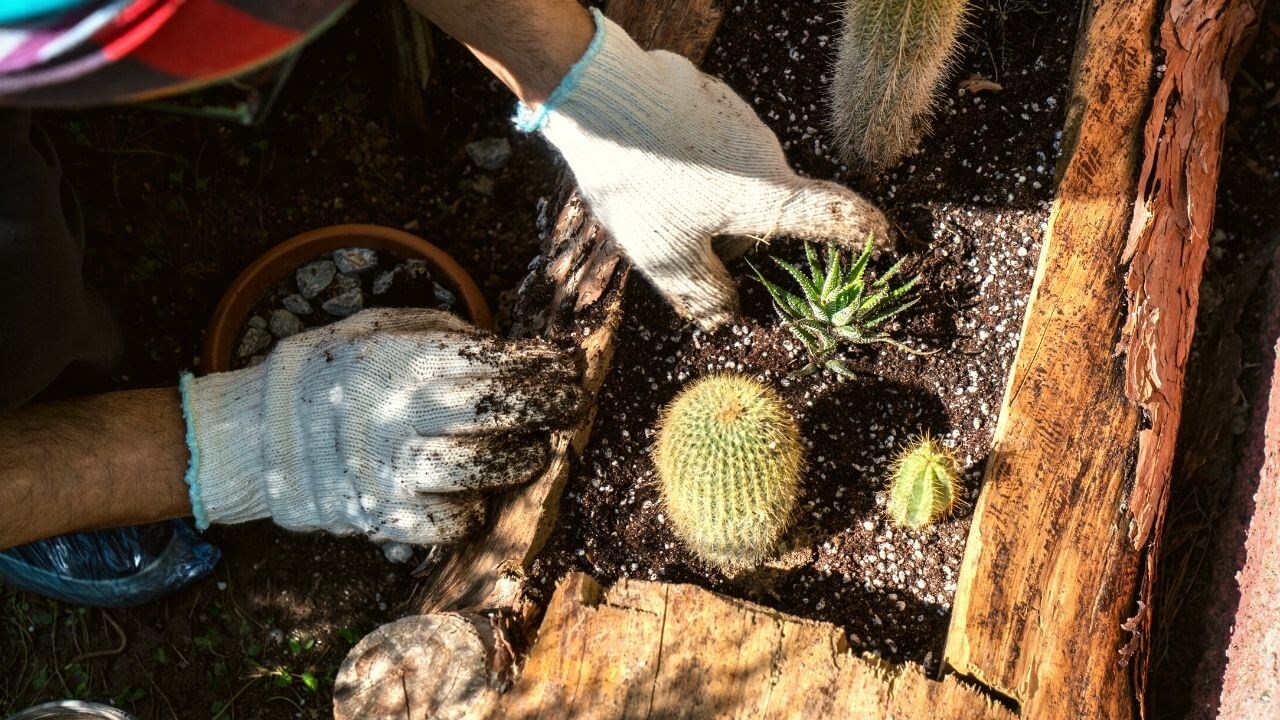You may be wondering if vermiculite is suitable for succulents. Succulent plants store water in their leaves for longer to thrive in drier environments. Vermiculite is a mineral often used in gardening because it helps retain moisture. So, if you’re looking for a way to keep your succulents healthy, you may consider using vermiculite.
One of the challenges people face with succulents is taking care of them properly. People often don’t know how to water and care for succulents, leading to the plants dying. Succulents need plenty of sunlight and moisture to thrive.
Suppose you don’t live in a climate conducive to succulents. In that case, you may want to consider using vermiculite to help keep them healthy. Vermiculite can help to retain water, which will help your succulents stay hydrated. You need to know the benefits of using vermiculite for succulents.
Quick Navigation
- 1 Does vermiculite help succulents grow?
- 2 How To Add Vermiculite To The Soil For Succulents?
- 3 What Are The Properties Of Vermiculite?
- 4 What Are Vermiculite’s Primary Gardening Uses?
- 5 What Are The Types Of Vermiculite?
- 6 What Extra Measures To Take While Mixing Vermiculite In The Soil For Succulents?
- 7 What Are The Advantages Of Using Vermiculite For Succulents?
- 8 What Are The Disadvantages Of Using Vermiculite For Succulents?
- 9 FAQ About If Vermiculite Is Good For Succulents
- 10 Conclusion
Does vermiculite help succulents grow?
Succulents are plants that store water in their leaves, stems, or roots to help them survive in dry climates. They come in various shapes and sizes and are found in many colors. While succulents can grow outdoors, they can also be grown indoors as houseplants. One of the most important things to remember when growing succulents is to provide them with the right type of soil. Having this is a huge benefit to succulents.
Succulents need well-draining soil that will hold moisture without becoming soggy. Vermiculite is a good choice for succulent soil because it drains well and helps to retain moisture. To create a custom soil mix for your succulents, you can mix vermiculite with potting soil or sand. Keep your succulents watered regularly, especially during the hot summer months.
How To Add Vermiculite To The Soil For Succulents?
It is possible to add vermiculite straight to the soil mix or compost and thoroughly mix them to be equally dispersed. To germinate seeds, they are employed in the soil as an insulator and aerator because of their ability to keep the soil cool and fresh.
Adding vermiculite to the soil can improve the health and growth of succulents because plant health will be directly related to the soil. Vermiculite can also help to keep pests away, as it is known to have repellent properties.
To add vermiculite to the soil:
- Make a small hole in the ground where you want the succulent to grow.
- Fill the hole with enough potting mix to cover the vermiculite but not submerge.
- Gently tamp down the potting mix around the vermiculite until uniformly distributed.
- Water your succulent well from the top, and enjoy your new addition to your garden!
- Never apply too much vermiculite since it will reduce the soil’s drainage ability and kill the succulents.
What Are The Properties Of Vermiculite?
Vermiculite is a standard product used in insulation, as a filler, and in manufacturing other products. The following are the properties of vermiculite:
Chemical Composition: Vermiculite is a magnesium silicate mineral. It is a hydrated aluminum silicate. It contains sodium, calcium, potassium, silicon, iron, magnesium, and aluminum.
Physical Properties: Vermiculite is an excellent insulating material because it is not very dense. Its high porosity, good thermal conductivity, and low cost make it a standard filler for insulation.
Applications: Vermiculite is used in many applications, including insulation, manufacturing, and construction.
What Are Vermiculite’s Primary Gardening Uses?
You can use vermiculite to absorb moisture and make your home more energy-efficient. It can also make a more comfortable bed by absorbing and retaining heat. Vermiculite is also used to prevent soil erosion and to increase the rate at which water seeps through the soil. Vermiculite is a beneficial product for homeowners.
Vermiculite is also used as an insulator in wall panels and thermal insulation in floors, roofs, and attics. This material is also used for horticulture as a growing medium for plants.
What Are The Types Of Vermiculite?
Vermiculite is a mineral that can use for different things such as insulation, water retention, and stability. Vermiculite has many uses and is found in many products.
Expanded Vermiculite
One of the most common types is expanded vermiculite. Expanded vermiculite is a form of vermiculite developed by heating the material. It makes it more effective as an insulator.
Exfoliated Vermiculite
Exfoliated vermiculite is a similar product to expanded vermiculite. Still, the material has been exfoliated or broken apart to make it more effective as an insulator. This type of vermiculite is commonly used in commercial buildings.
Precipitated Vermiculite
Precipitated vermiculite is a type of vermiculite that has been treated with chemicals. It makes it easier to handle and increases its effectiveness as an insulator. Precipitated vermiculite is typically used in industrial applications.
Mica Schist Vermiculite
The most common is Mica Schist. It is also the most expensive type of vermiculite. It makes various products, such as insulation, flooring, and roofing. There are many different ways to use this material to make these products, but one way is to use it as a filler in concrete. You can find it at most hardware stores, which is reasonably inexpensive.
What Extra Measures To Take While Mixing Vermiculite In The Soil For Succulents?
Suppose you are using vermiculite in your garden. In that case, taking a few extra measures is essential to ensure you get the most out of this soil amendment.
First, ensure that the vermiculite is well-mixed into the soil before planting. You can dig a hole and mix the vermiculite before replacing the ground.
Water the area well after planting to help the vermiculite settle in.
Finally, please wait a few weeks before harvesting to allow the plants to adjust to their new soil conditions.
What Are The Advantages Of Using Vermiculite For Succulents?
When it comes to succulents, there are a few different growing mediums that you can use. One of the more popular growing mediums is vermiculite. Vermiculite is a mineral often used in horticulture because it helps improve the soil’s structure and drainage. Additionally, it helps retain water and nutrients, making it the perfect growing medium for succulents.
There are several advantages of using vermiculite for succulents. First off, vermiculite retains water very well, so you will not need to water your succulents often. Second, vermiculite can help improve the soil’s structure and drainage. It is important for succulents since they need well-drained soil to thrive.
What Are The Disadvantages Of Using Vermiculite For Succulents?
There are some disadvantages to using vermiculite for succulents. Vermiculite is lightweight and water-retentive, which helps to keep the soil healthy. However, vermiculite can also be a source of problems for succulents.
One problem with vermiculite is that it can hold too much water and cause the roots of succulents to rot. In addition, vermiculite is a breeding ground for pests and diseases, harming succulent plants. You must be careful when working with this material because it can release dangerous asbestos fibers.
FAQ About If Vermiculite Is Good For Succulents
What Is The Best Soil Mix For Succulents?
A well-draining soil mix is best for succulents. This type of soil mix allows excess water to drain away from the roots, preventing the plant from sitting in wet soil, leading to root rot. You can make a well-draining soil mix by mixing equal parts of sand, perlite, and potting soil.
Which Is Better For Succulents, Perlite Or Vermiculite?
When deciding which of these two is better for succulents, perlite or vermiculite, there are a few things to consider.
The first is what type of succulents you have. If you have a succulent that requires more drainage, then perlite would be better. If you have a succulent that doesn’t need as much drainage, then vermiculite would be a much better option.
The second thing to consider is the climate you reside. Perlite would be better if you lived in a scorching and dry environment. You can go for vermiculite if you live in a more humid environment.
Which Plants Like Vermiculite?
Most plants like vermiculite. It allows them to grow faster and provides better soil drainage. It is not harmful to plants, but you should always look for a non-poisonous vermiculite product to avoid harming your houseplants.
Does Vermiculite Decompose?
Yes, vermiculite does decompose. It is a mineral used in horticulture and gardening to help the soil retain moisture and break up compacted soil. Vermiculite is also used as an additive in insulation materials. When exposed to air, it will start to decompose and release carbon dioxide gas. Over time, the vermiculite will disappear completely, leaving behind nothing but a hole in the ground.
What Substrate Is Best For Succulents?
The best substrate for succulents, per our recommendation, is perlite. It’s inexpensive and lightweight, and it allows for easy watering. It also prevents the roots from sticking to the pot too tightly, allowing you to move it around quickly. It’s also an excellent material for indoor houseplants, as it can provide ample moisture.
Can I Use Vermiculite For Cactus?
Yes, you can use vermiculite for cactus. It’s highly recommended that you remove the excess water before using it. As a result, you’ll be able to use your vermiculite as a potting material or a cactus soil enhancer. You can also use it to create a terrarium for small or large plants.
Conclusion
In conclusion, vermiculite is an excellent growing medium for succulents. Still, it is essential to consider the pH levels of vermiculite. The pH of vermiculite is neutral. Succulents prefer slightly acidic soil, so if your vermiculite is too alkaline, you may need to add some acid to the mix. Also, water your succulents regularly, especially in the hot summer, as vermiculite can quickly dry out.

My name is Md Robiul Islam and I’m a plant enthusiast. I like to have a garden and research different plants. I also have an interest in environmental science and would like to work in that field in the future.


